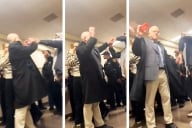You have /5 articles left.
Sign up for a free account or log in.
After the April 16 massacre at Virginia Tech, the lesson many came away with was that e-mail alone won't suffice to keep students informed about emergencies on campus. One solution widely regarded as both timely and technologically in sync with undergraduate habits was to use text messages to alert them to potential dangers.
Some colleges had already been in the process of upgrading to text (or "SMS," for Short Message Service protocol) alert systems by the time the killings turned them into a supposed necessity overnight. Since then, hundreds of campuses have upgraded their emergency communication networks or added text capability in evaluating their response plans. But questions are now being raised about how many students text alerts actually reach, and whether the messages are useful only in concert with other types of communication.
Virtually all college students come to campus with their own cell phones, but for privacy reasons, telecommunications companies require their subscribers to manually opt in to any mass alert service. The result is that in many cases, the primary obstacle to widespread campus access to text alerts is the students themselves.
"We're still in the advertising phase, encouraging people to sign up," said Gerald W. Schoenle Jr., the chief of police at the State University of New York at Buffalo. Students at the university must sign up online -- a process that takes a minute or two -- in order to receive text alerts, which Schoenle said would only be sent in a potential emergency situation. "We wouldn’t want it to be like spam or anything like that," he said. The results so far, with the program in only its second month of operation, is some 5,000 signups at a campus of about 28,000 -- less than 20 percent of the student population.
There are no national statistics available to quantify just what percentage of students take advantage of text alert systems. Generally, however, observers have seen a definite gap between the actual and intended audience for the messages. S. Daniel Carter, the senior vice president of Security on Campus, a nonprofit group that monitors campus safety issues, said he's seen reports varying from 3,000 to 9,000 signups at large universities with 15,000 to 25,000 students. "That’s just anecdotal," he said, adding that the organization might conduct a survey later this year to obtain more concrete data.
But one situation presents an exception to this apparent trend: campuses that have actually undergone emergencies. At St. John's University, in New York City, a scare involving an armed man on campus ended with an arrest -- and a tripling in the number of students who signed up for text alerts within 24 hours. The number -- over 6,500 from 2,100 the day before -- was still under half of the campus population of about 15,000, but university officials considered the jump significant. A similar but smaller increase was reported at the University of Memphis -- from under 4,700 to 6,000, out of 20,000 students -- after a junior was shot dead on Sept. 30.
Perhaps the most dramatic increase occurred after the first day of classes at the University of Colorado at Boulder, when officials notified the campus that a student had been stabbed repeatedly. The New York Times reported that almost 8,000 students (out of over 28,000) signed up for text alerts within five days, on top of the only 1,300 who had been previously enrolled. Even then, the percentage remained at about a third.
The question for campus safety officers is whether a penetration of 50 percent or less, even at colleges that have seen quick bumps in signups after potential security breaches, is whether that's a sufficient critical mass to keep people informed. The answer, so far, appears to be that text messages are only useful as long as they're part of a larger communication strategy.
"I wouldn’t say that anywhere between 20 to 50 percent enrollment is necessarily low," Carter said. "You want to get saturation, you want to get the word [out] ... if you have anywhere between 1 in 5 to 1 in 2, half your folks [receiving text alerts], they’re going to be able to spread the word in an emergency situation."
Rather than aim for 100 percent penetration, Carter said campuses should make text messages part of an integrated, multi-channel approach: e-mails and SMS, Web portals and voice messages, external speakers and phone trees.
"Having any one stream to connect with people is risky for a whole variety of reasons," said Natasha Rabe, the chief business officer of NTI Group, whose Connect-ED service for higher education counts nearly 200 clients. "If there’s a problem with that particular way of reaching somebody, you’re stuck."
With text alerts, especially, there are other barriers to worry about: the cost of a single message might turn off some students who'd worry about a barrage of notices about upcoming events or the beginning of fall break, for instance. And there are always privacy questions, even though companies that provide alert services assure users that their numbers are secure.
Rabe added that the length of text messages imposes a limit on what can be sent, as does the availability of readable characters. Her firm works with its clients to establish how to use text alerts as gateways to other modes of communication -- encouraging students to check for real-time updates on the Web or to read their e-mail, for example. Even voice messages offer "a sense of calm" when delivering important information, Rabe suggested.
"And any one of those components not being there is a detriment to the school," she said.
NTI has seen growth in its text alert service since as early as last November, according to Rabe, with a 350-percent increase in the number of customers since January. The company signed contracts with a number of large universities over the summer (and after Virginia Tech), she said.
"And we’ve seen a big disparity on college campuses in terms of their opt-in rate," from 30 to 50 percent up to 80 percent, and "we’re seeing very interesting and proactive reachout and awareness attempts," including what she dubbed "bribery attempts" such as iPod giveaway contests for students who sign up.
Buffalo signed a contract with another company, Rave Wireless, which sees an opening for a more comprehensive, bidirectional answer to the campus communication problem. For now, the campus is using the service only for emergency text alerts, but that could change if administrators and students see a need for more features. Montclair State University, one of the early adopers of SMS alert technology and also a Rave client, requires incoming students to buy cell phones that are compatible with the network.
The idea, said Raju Rishi, Rave's co-founder and chief strategy officer, is that the "digital divide between the administration and the students" is a perpetual fact of life: when campuses used voice mail to reach students in their dorms, students switched to cell phones. When colleges widely adopted e-mail, students had already started entering as freshmen with their own personal accounts. Now universities have invested millions of dollars in centralized, internal Web portals -- but students would rather be on Facebook.
"It's a massive problem," he said, because critical messages might not be received where they're disseminated.
Text messages were never intended as emergency notification tools, Rishi pointed out, and cell phone providers will often shift throughput from text to voice in the event of a local or national incident. The question is whether more colleges and universities (like Montclair State) will adopt Rave's solution, which is to place Palm-like technologies in the hands of their students -- essentially dedicated lifelines to and from the institution. Students can send and receive alerts in real time, use their phones as GPS-equipped "panic" devices instead of relying on Blue Light phones at night, and even use the devices as clickers in interactive classroom sessions.
"If [colleges] declare that it’s the only vehicle by which they’re going to communicate with students," Rishi suggested, there could be greater rates of adoption of text services.
But so far, no campus has put that theory to the test. Rave currently has some 50 clients, both for traditional SMS alerts and the more integrated solution. Any further growth -- at Rave, NTI and other companies -- could signal in which direction colleges are preparing to move.








